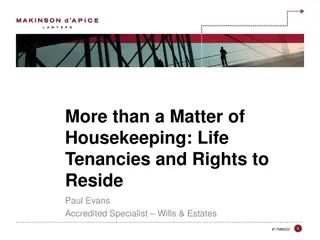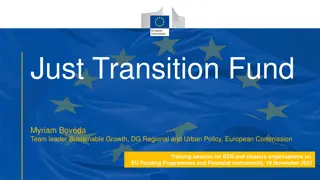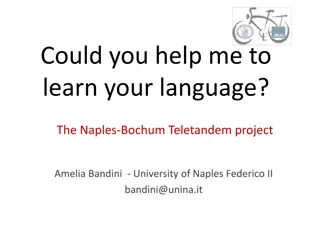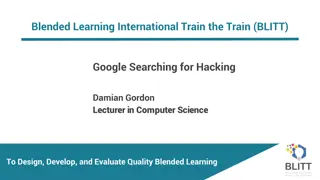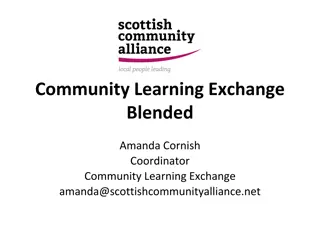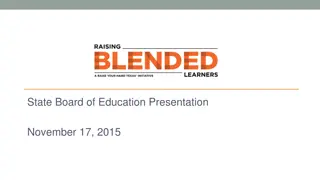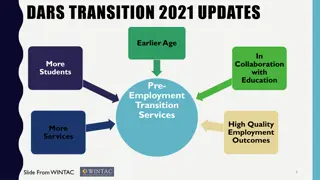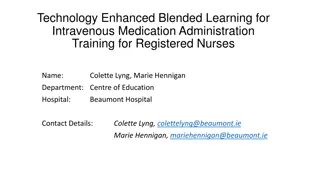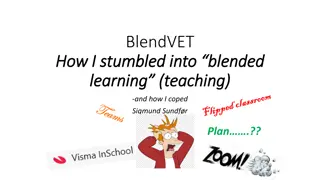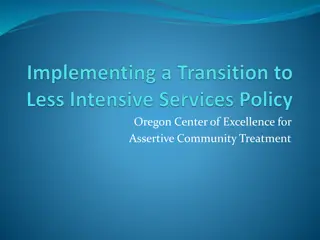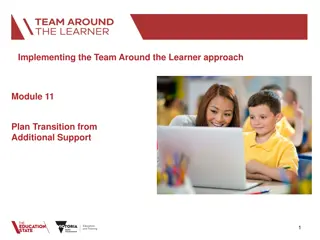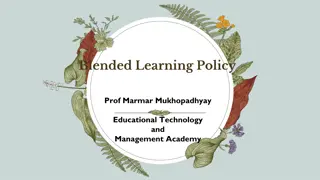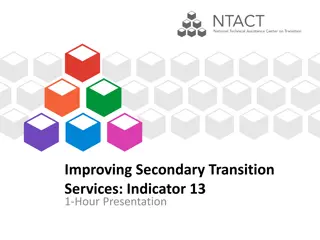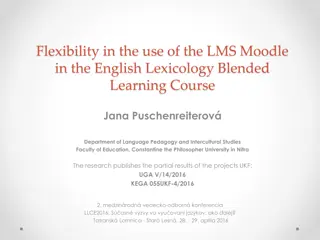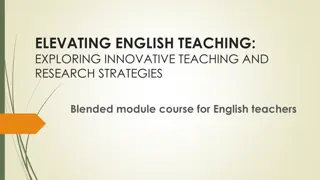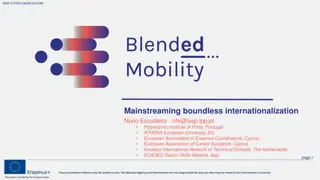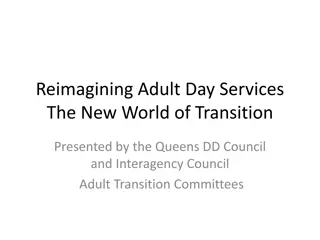Enhancing University Learning Through Blended Learning Transition
Switching from traditional to blended learning at university level offers benefits such as anytime-anywhere access, diverse learning opportunities, and increased confidence among learners. Studies show positive results in terms of access to course materials and improved student engagement. Implementing blended learning requires clear policies, faculty incentives, and reliable technology infrastructure. Making the transition addresses challenges in class scheduling, caters to digital-native students, and integrates online technologies for effective course delivery.
Download Presentation

Please find below an Image/Link to download the presentation.
The content on the website is provided AS IS for your information and personal use only. It may not be sold, licensed, or shared on other websites without obtaining consent from the author. Download presentation by click this link. If you encounter any issues during the download, it is possible that the publisher has removed the file from their server.
E N D
Presentation Transcript
The Principles and Mechanics of Switching From Traditional To Blended Learning Learning At University Level: Students and Lecturers Experiences Traditional To Blended W. Marc Jackman, Ph.D Centre for Education Programmes, University of Trinidad & Tobago.
Benefits 1. Blended course would be a great benefit for the learners due to its anytime-anywhere concept with a self-pace learning. 2. In addition, use of various digital technologies increases new learning opportunities and make learning more interesting (Arani, 2015). Blended-Learning module offers an opportunity to learners of different learning styles to utilize the lessons. 3. 4. 5. The Blended course module allowed the learners to access the lessons at their convenient time(Arani, 2015).
Results of Arani (2015) study the students of medicine enumerated the following: 1. ease of access to the course materials (%89), 2. an opportunity to receive EMP materials while they are out of the university or at their free time (%86), 3. and to gain more confidence in their homework (%71) thanks to the opportunity to compare their ability in four skills to those of their peers. 4. Also, thanks to blending, students gain greater awareness of audience issues teacher and feedbacks because peers provide a broader and more natural audience for their communications (%63).
Principles & mechanics of implementing Blended learning protocols Garrison and Kanuka (2004) outlined five steps that would enhance the effectiveness and efficiency of these models. 4. Fourth, the university needs to provide an innovation fund or financial support as incentives to faculty to initiate the blended learning transformation. Mechanics 1. First, there needs to be policy and a clear institutional direction. Principle 2. Second, it is important to increase awareness and frame the direction of the policy or new model. Principle 5. Fifth, a reliable and accessible technology infrastructure should be available to support students, faculty, and others. Mechanics 3. Third, it is useful to establish a single point of support, quality assurance, and project management. mechanics 6. Restructuring a class is time consuming and people are often more inclined to undertake a new instructional initiative if there is an incentive and support. mechanics & principles
Argument for making the switch in present study 1. Constraints on the scheduling of three- hour per week full time face-to-face classes -forced to explore creative alternatives to course delivery. 2. The need to facilitate the teaching of students born and socialized in the digital age- digital natives. 3. Need of university to deliver courses using integrated platforms that fuse face-to-face interaction with online technologies. 4. Implementation of blended learning was the fact that as an institute involved in teacher preparation experience and modelling
The research questions for this study include the following 1. What are principles and mechanics of implementing a blended instruction? 2. What benefits and challenges do students report from the blended learning experience? 3. What benefits and challenges do lecturers report from the blended learning experience?
Methodology Participants- 160 first year bachelor of education students & 5 lecturers Measures- Student Blended Learning Experience Questionnaire 9 closed ended & 4 open ended Teacher Blended Learning Experience Questionnaire -10 open ended Questionnaires Procedure- Blended learning implementation protocol Data collection & analysis Analysis- frequency analyses, & content analysis (approx. 400 responses/open ended question
The Actual Blended Learning Implementation 3. Assigning responsibility for video content preparation, distribution and delivery 1. Making the case for BL implementation 2. Re-conceptualizing, re- organizing the curriculum 4. Contacting and linking with the LRC and ICT 6. Preparation, Posting and hosting the videos Pre- posting and post-hosting assessment and activities 5. In-house, departmental and external training in the psychology department Experimenting with different software platforms 7. Integration of online and F2F, evaluation and assessment
Results of preliminary frequency analyses Preference for Blended Learning NO 15% YES 85%
More results Did you learn concepts better in BL or F2F 70.0 60.0 50.0 40.0 30.0 20.0 10.0 0.0 YES NO
More results 80% of students felt that the new blended learning approach allowed them more personal free time and 91% of students thought that the questions embedded in each video for review and reflection of the content helped them to focus on the concepts in each video. 76% of students believed that the exposure to videos created by lectures other than their own was a good idea.
When asked why they thought the blended learning approach was better 1. You can go over the video 2. You can view and review the video at any time 3. You can pause the video and research something you don t understand and start back the video 4. School hours are minimize 5. It was more interesting 6. Students can be comfortable doing the one hour video at home 7. The online video gives individual attention
The blended learning approach was better because 8. 9. Videos [were] more direct More or better concentration due to less time 10. Be able to revise work in simpler terms than the textbook 11. It gave me a feel of what online classes are like 12. It gives persons a greater sense of responsibility for their learning 13. More Time to understand & a internalize concepts & ask questions for guidance at next class 14. Questions at the end allowed reflection 15. Helps to develop a routine for studying
Students were also asked to list at least three things that made the videos interesting and valuable. 1. The questions at the end 2. I can review it over and over 3. The explanations that was given on the video and the pictures 4. The ability to download the video for later use 5. Giving examples and illustrations 6. One or two jokes were made 7. Other Graphical effects 8. I was able to make my notes and view on my time
At least three things that made the videos interesting and valuable 9. The amount of info that was given yet it was straight to the point 10.Hearing from a number of different lecturers 11.Audio with reinforced visuals 12.Summarized versions not too lengthy 13.They were interactive 14.I felt I was in an individual classroom 15.Cartoons
Students were also asked to identify a reason why they felt exposure to multiple lecturers was a good thing. Students responses included the following: 1. Different teaching styles 2. Because it allowed you a well rounded effect in the school 3. To familiarize with different lecturers 4. In meeting we hear other aspects of the lesson in a different ways 5. Enjoyed variety 6. A different voice and focus 7. Different perspectives of the lecturers
Students were also asked to identify a reason why they felt exposure to multiple videos was a bad thing. 1. Some lecturers were difficult to understand 2. Because it confused me the different voices 3. Teaching styles were different which made it a bit difficult to adjust to 4. They were too boring 5. Could not keep up 6. Because I prefer my teacher s teaching method 7. Other lecturers lack enthusiasm and creativity
Lecturer feedback What did you like about the blended learning experience this semester? I liked the different methodological approaches to teaching. Students got an opportunity to get different perspectives from the various Lecturers. Good movement way from three hour teaching because students can stop video and review. In reflection do you prefer the 3 hour face to face traditional lecture discussion of the new 2 hour in class one (1) online arrangement? What challenges did you experience with the blended learning experience? Initially, the technological skills. Got it after a while. Trying to condense the content I like the new 2 hour class, since the online segment helped some students to become self- regulated as they had to practice independently and be responsible for their own learning. you can t put down everything you would say if you were face-to-face. Trying to make it interactive.
Did you notice any difference in the students behaviour or attitude with the new arrangements? , If you did, briefly state it below. Students seem more relaxed and engaging in class. Sometimes I wondered if they were all viewing the videos. I did not notice any change of attitude really. Sometimes when I referred to something from a past video, some of them did not have a clue. How did you feel about using material prepared by other persons in the department? How would you describe creating the online videos that you did? At the start, stressful because I was feeling my way around. At the end I was proud of myself. I could talk to colleagues and even advise/help them to similar stuff. I still have a lot to learn though. It was very interesting to see the strategies and the creativity of my colleagues in the department I was quite happy to expose my students to others
Recommendations 1. Reduce work load 2. Make videos shorter 3. More interactive 4. Group discussions on different topics 5. Less robotic talking 6. Add animations to keep learner s interest 7. Videos to be on time 8. Better audio 9. Online feedback if you do not understand
Student recommendations for improving the blended learning experience 10. The face to face should be more like the videos 11. Live videos 12. A website to better access them 13. MCQs with answer sheet so students can test their understanding 14. Longer pauses between slides 15. Open forum for discussion 16. In-class recap of videos 17. Longer videos and more online time
Discussion & conclusion This first attempt was successful. Lots of room for principle and mechanical development Additional room for more critical research Blended learning is the wave of the future. Thank you.




